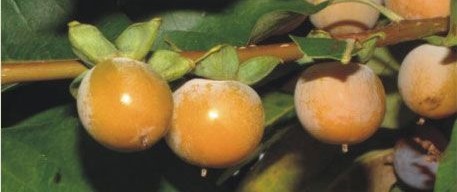The genus name means fruit of the gods in Ancient Greek. Its Turkish equivalent, the date of paradise, indicates the same connection and is related to the fact that the fruits of the genus were considered divine in antiquity. The species name means lotus in Ancient Greek. It is speculated that the fruits consumed by the “lotus eaters” in Homer’s Odyssey may be the fruits of this tree, but it is not clear which fruit is the lotus fruit. There are many guesses and jujube (Ziziphus lotus) is one of them. The pre-binary names are “Lotus africana latifolia” and “Pseudo Lotus”.
Diospyros lotus, commonly known as the Date-Plum, is a deciduous tree with unique fruit that resembles a combination of plums and dates. Here’s some information about Diospyros lotus and where it grows:

- Botanical Description:
- Diospyros lotus is a deciduous tree that can grow up to 9-15 meters in height.
- It is known for its distinctive fruit, which has a taste reminiscent of both plums and dates.
- The species is dioecious, meaning individual trees are either male or female, and both are required for fruit production.
- Growing Conditions:
- Diospyros lotus is hardy and can grow in various climate conditions.
- It is suitable for UK Zone 5 and is not frost tender.
- The tree flowers in July, and its fruit typically ripens from October to November.
- Geographical Distribution:
- Diospyros lotus can be found in various locations, and its adaptability allows it to thrive in different regions.
- It is harvested from the wild for local use as a food source in some areas.
In summary, Diospyros lotus, or the Date-Plum, is a deciduous tree with plum-date-like fruit. It is hardy and can grow in different climates, making it adaptable to various regions. It’s not limited to a specific geographical location, and its fruit is harvested for local consumption in some areas.
How do you grow Diospyros Lotus?
Diospyros lotus, commonly known as date-plum or Caucasian persimmon, is a fruit-bearing tree or shrub that can be grown in suitable climates. Here are the general steps to grow Diospyros lotus:
1. Climate and Location:
- Diospyros lotus is native to the Mediterranean region and prefers a subtropical or Mediterranean climate. It thrives in areas with hot, dry summers and mild, wet winters.
- Plant Diospyros lotus in a location that receives full sun, as it requires plenty of sunlight to grow and produce fruit.
2. Soil:
- Choose well-draining, loamy soil with a slightly acidic to neutral pH (around 6.0 to 7.5).
- Amending the soil with organic matter, such as compost, can improve soil fertility and moisture retention.
3. Planting:
- Plant Diospyros lotus in the spring or fall when the weather is mild and there is adequate moisture.
- Dig a hole that is roughly the same depth as the root ball and about twice as wide.
- Place the tree or shrub in the hole, making sure the top of the root ball is level with the soil surface.
- Fill the hole with soil and pat it down gently to remove air pockets.
- Water the plant thoroughly after planting.
4. Watering:
- Provide regular and consistent moisture, especially during the growing season and dry periods. Keep the soil evenly moist but not waterlogged.
- Water deeply and avoid frequent shallow watering to encourage deep root growth.
5. Mulching:
- Apply a layer of organic mulch around the base of the plant to help retain soil moisture, regulate soil temperature, and reduce weed competition.
6. Pruning:
- Prune the plant as needed to maintain its shape and remove dead or diseased branches. Diospyros lotus can be trained as a tree or shrub, depending on your preference.
7. Fertilization:
- Fertilize the plant with a balanced, slow-release fertilizer in the spring to promote healthy growth.
8. Support:
- Young Diospyros lotus plants may benefit from staking or support to help them establish a strong and upright structure.
9. Pest and Disease Management:
- Keep an eye out for common pests and diseases that may affect Diospyros lotus and take appropriate measures to manage them if necessary.
10. Harvesting:
- Depending on the specific variety and climate, Diospyros lotus typically produces fruit in late summer to early fall. Harvest the fruit when it reaches full ripeness and has a sweet, pleasant flavor.
Growing Diospyros lotus can be a rewarding endeavor, especially in regions with suitable climates. Ensure that you choose a suitable variety for your specific location and provide the necessary care to encourage healthy growth and fruit production.
Is diospyros lotus fruit edible?
Yes, the fruit of Diospyros lotus, commonly known as date-plum or Caucasian persimmon, is edible. The fruit is typically enjoyed for its sweet and flavorful taste when fully ripe. Diospyros lotus fruits are small and round, and their taste is often described as sweet and date-like, hence the common name “date-plum.”
The fruit of Diospyros lotus can be eaten fresh when it has ripened to its full sweetness. It is a popular fruit in some Mediterranean and Middle Eastern regions, where it is consumed as a fresh snack or used in culinary preparations.
However, it’s important to note that the unripe fruit can be astringent and somewhat bitter, so it is generally best to wait until the fruit is fully ripe before consuming it. The ripened fruit has a pleasant and sweet flavor, making it a desirable addition to the fruit basket in regions where Diospyros lotus is cultivated.
As with any fruit, the taste and texture can vary depending on the specific variety and ripeness of the fruit. If you are considering growing or consuming Diospyros lotus fruit, it’s advisable to try fruit from your local region or seek guidance on the best varieties and ripeness indicators from local experts or fruit enthusiasts.
